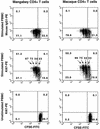Normal T-cell turnover in sooty mangabeys harboring active simian immunodeficiency virus infection
- PMID: 10627531
- PMCID: PMC111455
- DOI: 10.1128/jvi.74.3.1209-1223.2000
Normal T-cell turnover in sooty mangabeys harboring active simian immunodeficiency virus infection
Abstract
Sooty mangabeys naturally infected with simian immunodeficiency virus (SIV) remain healthy though they harbor viral loads comparable to those in rhesus macaques that progress to AIDS. To assess the immunologic basis of disease resistance in mangabeys, we compared the effect of SIV infection on T-cell regeneration in both monkey species. Measurement of the proliferation marker Ki-67 by flow cytometry showed that mangabeys harbored proliferating T cells at a level of 3 to 4% in peripheral blood irrespective of their infection status. In contrast, rhesus macaques demonstrated a naturally high fraction of proliferating T cells (7%) that increased two- to threefold following SIV infection. Ki-67(+) T cells were predominantly CD45RA(-), indicating increased proliferation of memory cells in macaques. Quantitation of an episomal DNA product of T-cell receptor alpha rearrangement (termed alpha1 circle) showed that the concentration of recent thymic emigrants in blood decreased with age over a 2-log unit range in both monkey species, consistent with age-related thymic involution. SIV infection caused a limited decrease of alpha1 circle numbers in mangabeys as well as in macaques. Dilution of alpha1 circles by T-cell proliferation likely contributed to this decrease, since alpha1 circle numbers and Ki-67(+) fractions correlated negatively. These findings are compatible with immune exhaustion mediated by abnormal T-cell proliferation, rather than with early thymic failure, in SIV-infected macaques. Normal T-cell turnover in SIV-infected mangabeys provides an explanation for the long-term maintenance of a functional immune system in these hosts.
Figures










References
-
- Ameisen J C, Capron A. Cell dysfunction and depletion in AIDS: the programmed cell death hypothesis. Immunol Today. 1991;12:102–105. - PubMed
-
- Baskin G, Murphey-Corb M, Martin L, Davison-Fairburn B, Hu F-S, Kuebler D. Thymus in simian immunodeficiency virus-infected rhesus monkeys. Lab Investig. 1991;65:400–407. - PubMed
-
- Baskin G B, Murphey-Corb M, Watson E A, Martin L N. Necropsy findings in rhesus monkeys experimentally infected with cultured simian immunodeficiency virus (SIV)/delta. Vet Pathol. 1988;25:456–467. - PubMed
-
- Bell E B, Sparshott S M, Bunce C. CD4+ T-cell memory, CD45R subsets and the persistence of antigen—a unifying concept. Immunol Today. 1998;19:60–64. - PubMed
Publication types
MeSH terms
Substances
Associated data
- Actions
- Actions
- Actions
- Actions
- Actions
- Actions
- Actions
- Actions
- Actions
- Actions
- Actions
- Actions
- Actions
Grants and funding
LinkOut - more resources
Full Text Sources
Other Literature Sources

